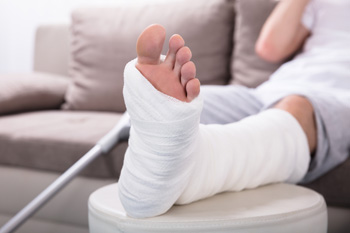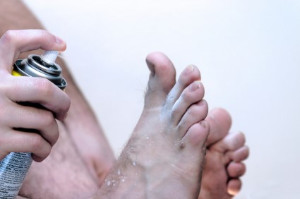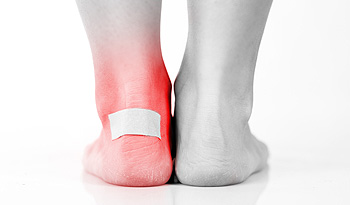June 2021
What Are the Signs of a Broken Ankle?
 A broken ankle or ankle fracture refers to a break or a hairline crack in any of the bones that make up the ankle. While rarely life-threatening, ankle fractures can be extremely painful. If you have fractured your ankle you may experience pain, swelling, bruising, deformity, numbness or tingling, limited ankle mobility, and an inability to bear weight on the affected ankle. In the case of an open fracture, you may see the broken bone poking through the skin. Ankle fractures require prompt medical attention. They are usually diagnosed through physical examination and imaging studies like X-rays. If you are suffering from the symptoms of a broken ankle, please seek the care of a podiatrist as soon as possible.
A broken ankle or ankle fracture refers to a break or a hairline crack in any of the bones that make up the ankle. While rarely life-threatening, ankle fractures can be extremely painful. If you have fractured your ankle you may experience pain, swelling, bruising, deformity, numbness or tingling, limited ankle mobility, and an inability to bear weight on the affected ankle. In the case of an open fracture, you may see the broken bone poking through the skin. Ankle fractures require prompt medical attention. They are usually diagnosed through physical examination and imaging studies like X-rays. If you are suffering from the symptoms of a broken ankle, please seek the care of a podiatrist as soon as possible.
Broken ankles need immediate treatment. If you are seeking treatment, contact Dr. Scott Shrem from Garden State Foot & Ankle Center. Our doctor can provide the care you need to keep you pain-free and on your feet.
Broken Ankles
A broken ankle is experienced when a person fractures their tibia or fibula in the lower leg and ankle area. Both of these bones are attached at the bottom of the leg and combine to form what we know to be our ankle.
When a physician is referring to a break of the ankle, he or she is usually referring to a break in the area where the tibia and fibula are joined to create our ankle joint. Ankles are more prone to fractures because the ankle is an area that suffers a lot of pressure and stress. There are some obvious signs when a person experiences a fractured ankle, and the following symptoms may be present.
Symptoms of a Fractured Ankle
- Excessive pain when the area is touched or when any pressure is placed on the ankle
- Swelling around the area
- Bruising of the area
- Area appears to be deformed
If you suspect an ankle fracture, it is recommended to seek treatment as soon as possible. The sooner you have your podiatrist diagnose the fracture, the quicker you’ll be on the way towards recovery.
If you have any questions, please feel free to contact our office located in Hazlet, NJ . We offer the newest diagnostic and treatment technologies for all your foot care needs.
Wounds That Don't Heal Need to Be Checked
Athlete’s Foot: Not Just for Athletes
Athlete’s Foot is a fungal infection that affects the skin on the feet. Despite its name, this fungal infection does not only occur in athletes. In fact, Athlete’s foot affects 1 out of 10 Americans. Athlete’s Foot is also known as dermatophytosis of the foot or tinea pedis. The fungi that are responsible for this condition feed on skin proteins called keratin, and love hot and steamy environments such as locker rooms, swimming pools, non-breathable footwear, and blisters and cuts on the feet which allow them access into your system. Getting a proper diagnosis is important in order for your podiatrist to rule out other conditions such as eczema and psoriasis, and to provide proper treatment.
Athlete’s foot is an inconvenient condition that can be easily reduced with the proper treatment. If you have any concerns about your feet and ankles, contact Dr. Scott Shrem from Garden State Foot & Ankle Center. Our doctor will treat your foot and ankle needs.
Athlete’s Foot: The Sole Story
Athlete's foot, also known as tinea pedis, can be an extremely contagious foot infection. It is commonly contracted in public changing areas and bathrooms, dormitory style living quarters, around locker rooms and public swimming pools, or anywhere your feet often come into contact with other people.
Solutions to Combat Athlete’s Foot
- Hydrate your feet by using lotion
- Exfoliate
- Buff off nails
- Use of anti-fungal products
- Examine your feet and visit your doctor if any suspicious blisters or cuts develop
Athlete’s foot can cause many irritating symptoms such as dry and flaking skin, itching, and redness. Some more severe symptoms can include bleeding and cracked skin, intense itching and burning, and even pain when walking. In the worst cases, Athlete’s foot can cause blistering as well. Speak to your podiatrist for a better understanding of the different causes of Athlete’s foot, as well as help in determining which treatment options are best for you.
If you have any questions please feel free to contact our office located in Hazlet, NJ . We offer the newest diagnostic and treatment technologies for all your foot and ankle needs.
Risk Factors and Treatments for Toenail Infections
 Toenail fungus, also known as onychomycosis, is an infection that leads to the destruction of the nails as they become discolored, yellowed, thickened, and brittle, often causing them to break. The variety of fungi that cause onychomycosis thrive in dark, warm, and moist environments such as sweaty shoes, showers, and public locker rooms and pools. Risk factors that can lead to developing a toenail fungus include poor foot hygiene, wearing nail polish, having a chronic disease such as diabetes, and frequently using community showers or pools. Because toenail infections rarely heal on their own, consulting with a podiatrist may be necessary. If the infection is in a small part of the nail, a topical antifungal medication may be prescribed, however for larger infections, an oral antifungal medicine may be necessary. In extreme situations, a podiatrist may need to surgically remove the nail.
Toenail fungus, also known as onychomycosis, is an infection that leads to the destruction of the nails as they become discolored, yellowed, thickened, and brittle, often causing them to break. The variety of fungi that cause onychomycosis thrive in dark, warm, and moist environments such as sweaty shoes, showers, and public locker rooms and pools. Risk factors that can lead to developing a toenail fungus include poor foot hygiene, wearing nail polish, having a chronic disease such as diabetes, and frequently using community showers or pools. Because toenail infections rarely heal on their own, consulting with a podiatrist may be necessary. If the infection is in a small part of the nail, a topical antifungal medication may be prescribed, however for larger infections, an oral antifungal medicine may be necessary. In extreme situations, a podiatrist may need to surgically remove the nail.
For more information about treatment, contact Dr. Scott Shrem of Garden State Foot & Ankle Center. Our doctor can provide the care you need to keep you pain-free and on your feet.
Toenail Fungus Treatment
Toenail fungus is a condition that affects many people and can be especially hard to get rid of. Fortunately, there are several methods to go about treating and avoiding it.
Antifungals & Deterrence
Oral antifungal medicine has been shown to be effective in many cases. It is important to consult with a podiatrist to determine the proper regiment for you, or potentially explore other options.
Applying foot powder on the feet and shoes helps keep the feet free of moisture and sweat.
Sandals or open toed shoes – Wearing these will allow air movement and help keep feet dry. They also expose your feet to light, which fungus cannot tolerate. Socks with moisture wicking material also help as well.
If you have any questions please feel free to contact our office located in Hazlet, NJ . We offer the newest diagnostic tools and technology to treat your foot and ankle needs.
What to Do if You Have a Foot Blister
Blisters on the feet are a common occurrence. They are usually the result of friction from your shoes rubbing against a specific area of skin. A blister forms as a natural protective measure to shield raw skin under a bubble of liquid. If you find a friction blister on your foot, cover it with a soft or padded bandage or dressing. Do not pop the blister, as this will expose the raw skin underneath it to dirt and bacteria and may lead to an infection. If the blister pops naturally, wash your hands prior to touching the blister. Allow the fluid to drain and then cover the area with a bandage. Blisters usually heal on their own, without medical intervention. However, if you have a particularly painful blister, the blister is showing signs of infection, or you have recurring blisters on your feet, please seek the care of a podiatrist.
Blisters are prone to making everyday activities extremely uncomfortable. If your feet are hurting, contact Dr. Scott Shrem of Garden State Foot & Ankle Center. Our doctor can provide the care you need to keep you pain-free and on your feet.
Foot Blisters
Foot blisters develop as a result of constantly wearing tight or ill-fitting footwear. This happens due to the constant rubbing from the shoe, which can often lead to pain.
What Are Foot Blisters?
A foot blister is a small fluid-filled pocket that forms on the upper-most layer of the skin. Blisters are filled with clear fluid and can lead to blood drainage or pus if the area becomes infected.
How Do Blisters Form?
Blisters on the feet are often the result of constant friction of skin and material, usually by shoe rubbing. Walking in sandals, boots, or shoes that don’t fit properly for long periods of time can result in a blister. Having consistent foot moisture and humidity can easily lead to blister formation.
Prevention & Treatment
It is important to properly care for the affected area in order to prevent infection and ease the pain. Do not lance the blister and use a Band-Aid to provide pain relief. Also, be sure to keep your feet dry and wear proper fitting shoes. If you see blood or pus in a blister, seek assistance from a podiatrist.
If you have any questions, please feel free to contact our office located in Hazlet, NJ . We offer the newest diagnostic and treatment technologies for all your foot care needs.
All About Ankle Replacement Surgery
 Ankle replacement surgery has become an increasingly common operation in the United States. Much like hips and knees, ankle joints can be affected by arthritis, injuries, and wear and tear over time that can cause severe pain in the ankle and limit mobility. In severe cases, the joint may become damaged enough to necessitate joint replacement surgery. People who undergo this operation are usually between the ages of 40 and 60. During the operation, the damaged bone and cartilage in the ankle joint are removed and replaced with an implant to form a new ankle joint. After fully recovering from the surgery, patients report improved ankle function and range of motion. To learn more about ankle joint replacement surgery and to find out if this is the right treatment for you, please consult with a podiatrist.
Ankle replacement surgery has become an increasingly common operation in the United States. Much like hips and knees, ankle joints can be affected by arthritis, injuries, and wear and tear over time that can cause severe pain in the ankle and limit mobility. In severe cases, the joint may become damaged enough to necessitate joint replacement surgery. People who undergo this operation are usually between the ages of 40 and 60. During the operation, the damaged bone and cartilage in the ankle joint are removed and replaced with an implant to form a new ankle joint. After fully recovering from the surgery, patients report improved ankle function and range of motion. To learn more about ankle joint replacement surgery and to find out if this is the right treatment for you, please consult with a podiatrist.
In certain cases, in which the patient suffers from extreme pain or damage in a joint, joint replacement surgery may be deemed useful. If you have constant pain in a foot joint, consult with Dr. Scott Shrem from Garden State Foot & Ankle Center. Our doctor will assess your condition and provide you with quality foot and ankle treatment.
What Is Joint Replacement Surgery?
Over time, joints wear down; this can be exacerbated by diseases and conditions. Joint replacement surgery, also known as arthroplasty, is when a damaged joint is surgically removed and replaced with a prosthesis. Prostheses, which can be made of ceramic, plastic, or metal, act as joints in lieu of an actual joint. One of the most prevalent causes for joint replacement is arthritis.
Arthritis in the Foot
Arthritis can occur in any joint in the body, including in the feet. Common types of arthritis in the foot are osteoarthritis, rheumatoid arthritis, and gout. The big toe is usually where arthritis occurs in the foot; this is known as hallux rigidus.
Joint Replacement Surgery in the Foot
The most common form of joint replacement in the foot is a first metatarsophalangeal (MTP) joint placement. MTP joint replacement surgery is designed to treat hallux rigidus. Surgery is not intensive, and recovery occurs within one to two months after the procedure has been done. Overall, joint replacement surgery is a safe and effective way to treat pain in the joint of the foot.
If you have any questions, please feel free to contact our office located in Hazlet, NJ . We offer the newest diagnostic and treatment technologies for all your foot care needs.
Blog Archives
- April 2025
- March 2025
- February 2025
- January 2025
- December 2024
- November 2024
- October 2024
- September 2024
- August 2024
- July 2024
- June 2024
- May 2024
- April 2024
- March 2024
- February 2024
- January 2024
- December 2023
- November 2023
- October 2023
- September 2023
- August 2023
- July 2023
- June 2023
- May 2023
- April 2023
- March 2023
- February 2023
- January 2023
- December 2022
- November 2022
- October 2022
- September 2022
- August 2022
- July 2022
- June 2022
- May 2022
- April 2022
- March 2022
- February 2022
- January 2022
- December 2021
- November 2021
- October 2021
- September 2021
- August 2021
- July 2021
- June 2021
- May 2021
- April 2021
- March 2021
- February 2021
- January 2021
- December 2020
- November 2020
- October 2020
- September 2020
- August 2020
- July 2020
- June 2020
- May 2020
- April 2020
- March 2020
- February 2020
- January 2020
- December 2019
- November 2019
- October 2019
- September 2019
- August 2019
- July 2019
- June 2019
- May 2019
- April 2019
- March 2019
- February 2019
- January 2019
- December 2018
- November 2018
- October 2018
- September 2018
- August 2018
- July 2018
- June 2018
- May 2018
- April 2018
- March 2018











